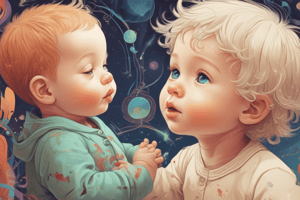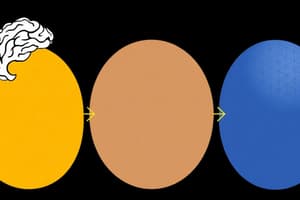Podcast
Questions and Answers
What type of processing occurs consciously and requires attention?
What type of processing occurs consciously and requires attention?
- Effortful processing (correct)
- Implicit processing
- Automatic processing
- Sensory processing
What is the primary function of short term memory?
What is the primary function of short term memory?
- Storing information indefinitely
- Holding onto small bits of information recently learned
- Transferring information to implicit memory
- Recognizing stimuli from sensory memory (correct)
In which type of memory is factual knowledge that is true for everyone categorized?
In which type of memory is factual knowledge that is true for everyone categorized?
- Working memory
- Implicit memory
- Semantic memory (correct)
- Episodic memory
What type of memory does not require conscious awareness but influences behavior?
What type of memory does not require conscious awareness but influences behavior?
What term describes the ability to generate a mental image of an absent stimulus?
What term describes the ability to generate a mental image of an absent stimulus?
Which type of attention involves responding discreetly to specific stimuli?
Which type of attention involves responding discreetly to specific stimuli?
What is a characteristic of long term memory?
What is a characteristic of long term memory?
What best describes working memory?
What best describes working memory?
What is the primary characteristic of sustained attention?
What is the primary characteristic of sustained attention?
Which grasping pattern is most efficient for manipulating objects?
Which grasping pattern is most efficient for manipulating objects?
At what age does the lateral pincer grasp typically emerge?
At what age does the lateral pincer grasp typically emerge?
What type of attention involves the ability to respond to multiple task demands at the same time?
What type of attention involves the ability to respond to multiple task demands at the same time?
Which stage represents the first occurrence of a voluntary grasp?
Which stage represents the first occurrence of a voluntary grasp?
What type of play is characterized by the use of unrealistic objects?
What type of play is characterized by the use of unrealistic objects?
When do children typically start exhibiting the dynamic tripod grasp of writing instruments?
When do children typically start exhibiting the dynamic tripod grasp of writing instruments?
At what age do infants typically begin to swipe at objects and reach towards toys?
At what age do infants typically begin to swipe at objects and reach towards toys?
At what age do children typically begin to show the first representational forms in drawing development?
At what age do children typically begin to show the first representational forms in drawing development?
What is the primary achievement in language development for infants at age 10 months?
What is the primary achievement in language development for infants at age 10 months?
Which of the following milestones occurs around age 5 in handwriting development?
Which of the following milestones occurs around age 5 in handwriting development?
Which milestone indicates a development of interaction skills in infants by 12 months?
Which milestone indicates a development of interaction skills in infants by 12 months?
When do children typically experience an increase in vocabulary of about 20 new words a day?
When do children typically experience an increase in vocabulary of about 20 new words a day?
What is a prominent feature of pragmatic language development for children aged 6-7 years?
What is a prominent feature of pragmatic language development for children aged 6-7 years?
At what age do children typically learn to connect letters with language sounds?
At what age do children typically learn to connect letters with language sounds?
What is a common characteristic of cooing in infants?
What is a common characteristic of cooing in infants?
What is the primary focus of the secondary circular reactions stage in sensorimotor development?
What is the primary focus of the secondary circular reactions stage in sensorimotor development?
At what age is mental representation developed in sensorimotor stages?
At what age is mental representation developed in sensorimotor stages?
Which type of brain growth refers to the organization developing rapidly due to ordinary experiences?
Which type of brain growth refers to the organization developing rapidly due to ordinary experiences?
What is meant by object permanence in cognitive development?
What is meant by object permanence in cognitive development?
Which gross motor skill is typically developed first?
Which gross motor skill is typically developed first?
What best describes the function of the central executive in executive functioning?
What best describes the function of the central executive in executive functioning?
What is a key characteristic of experience-dependent brain growth?
What is a key characteristic of experience-dependent brain growth?
What age range is associated with primary circular reactions in infants?
What age range is associated with primary circular reactions in infants?
Flashcards
Object Permanence
Object Permanence
The ability to understand that objects continue to exist even when they are out of sight.
Sensorimotor Stage
Sensorimotor Stage
A stage in Piaget's theory where infants learn through their senses and motor actions. It consists of six substages.
Brain Plasticity
Brain Plasticity
The ability of the brain to develop and change in response to experiences.
Sensory Register
Sensory Register
Signup and view all the flashcards
Short-Term Memory
Short-Term Memory
Signup and view all the flashcards
Long-Term Memory
Long-Term Memory
Signup and view all the flashcards
Experience-Expectant Brain Growth
Experience-Expectant Brain Growth
Signup and view all the flashcards
Experience-Dependent Brain Growth
Experience-Dependent Brain Growth
Signup and view all the flashcards
Sustained Attention
Sustained Attention
Signup and view all the flashcards
Selective Attention
Selective Attention
Signup and view all the flashcards
Alternating Attention
Alternating Attention
Signup and view all the flashcards
Divided Attention
Divided Attention
Signup and view all the flashcards
Joint Attention
Joint Attention
Signup and view all the flashcards
Pretend/Symbolic Play
Pretend/Symbolic Play
Signup and view all the flashcards
Mature Grasp
Mature Grasp
Signup and view all the flashcards
Immature Grasp
Immature Grasp
Signup and view all the flashcards
Working Memory
Working Memory
Signup and view all the flashcards
Explicit Memory
Explicit Memory
Signup and view all the flashcards
Semantic Memory
Semantic Memory
Signup and view all the flashcards
Episodic Memory
Episodic Memory
Signup and view all the flashcards
Implicit Memory
Implicit Memory
Signup and view all the flashcards
Recognition Memory
Recognition Memory
Signup and view all the flashcards
Recall Memory
Recall Memory
Signup and view all the flashcards
Remote Memory
Remote Memory
Signup and view all the flashcards
Fine Motor Control
Fine Motor Control
Signup and view all the flashcards
Handwriting Development
Handwriting Development
Signup and view all the flashcards
Language Development
Language Development
Signup and view all the flashcards
Metalinguistic Awareness
Metalinguistic Awareness
Signup and view all the flashcards
Pragmatic Language
Pragmatic Language
Signup and view all the flashcards
Drawing Development
Drawing Development
Signup and view all the flashcards
Cooing and Babbling
Cooing and Babbling
Signup and view all the flashcards
Two-Word Utterances
Two-Word Utterances
Signup and view all the flashcards
Study Notes
Sensorimotor Stages
- Reflexive schemes: Birth to 1 month; newborn reflexes.
- Primary circular reactions: 1-4 months; simple motor habits focused on the infant's body.
- Secondary circular reactions: 4-8 months; repeating actions that produce interesting effects in the environment.
- Coordination of secondary circular reactions: 8-12 months; intentional goal-directed behaviour.
- Tertiary circular reactions: 12-18 months; exploring object properties through experimentation.
- Mental representation: 18 months-2 years; internal depictions of objects, events, and solutions to problems.
- Gross Motor Development: Walking, running, jumping, skipping (covered separately).
Brain Growth
- Experience-expectant brain growth: Early brain development relying on typical experiences (e.g., environment, interactions, sounds).
- Experience-dependent brain growth: Lifelong brain growth that refines existing structures based on individual experiences.
Cognitive Principles and Theories
- Object permanence: Understanding that objects continue to exist even when out of sight.
- Central executive/executive functioning: Directs information flow and complex tasks.
- Information processing: Stages (sensory register, short-term memory, long-term memory) and processes (e.g., automatic and effortful processing).
- Sensory register: Initial stage, processing sensory input briefly.
- Short-term memory: Briefly holds information.
- Long-term memory: Permanent storage.
Sensory Registry
- Sensory input is initially processed in the sensory register.
- Paying more attention increases likelihood of that info being further processed.
Memory
- Short-term memory: Information from the sensory register enters consciousness.
Attention
- Focus attention: Responding to specific stimuli.
- Sustained attention: Maintaining focus over time.
- Selective attention: Focusing on relevant stimuli, filtering out distractions.
- Alternating attention: Shifting focus between tasks.
- Divided attention: Attending to multiple tasks simultaneously.
- Joint attention: Sharing attention with another person on a common object.
Play
- Levels of Play: Pretend/symbolic play, make-believe play using realistic objects
Reaching and Grasping
- Developmental sequences: specific ages and stages of hand movements related to reach and grasp abilities.
Language Development
- Cooing and babbling: Early vocalizations with increasing complexity.
- First words: Vocabulary increases significantly in middle childhood.
Social Context of Early Development
- Zone of proximal development: The difference between what a child can do independently, and what they can accomplish with guidance.
- Just right challenge: Tasks that are motivating without being beyond the child's ability.
Social and Emotional Intelligence
- Skills related to understanding and expressing emotions, behavior toward others, and relating to social contexts.
Additional
- Intermodal perception: Integrating information from multiple senses simultaneously.
- Social structures: (e.g., prejudice and favoritism)
Studying That Suits You
Use AI to generate personalized quizzes and flashcards to suit your learning preferences.
Related Documents
Description
Explore the various sensorimotor stages from birth to two years, detailing reflexive schemes and the development of motor skills. Additionally, learn about the concepts of experience-expectant and experience-dependent brain growth, crucial for understanding early development.




